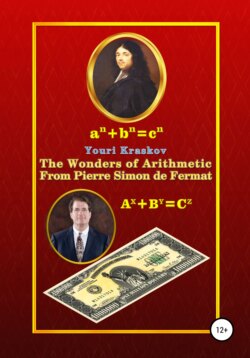Читать книгу The Wonders of Arithmetic from Pierre Simon de Fermat - Youri Veniaminovich Kraskov - Страница 12
3. What is a Number?
3.4. The Descent Method
3.4.4. Fermat’s Problem with Age 385 years
ОглавлениеIn the original version in 1636 this task was formulated as follows:
Find two square-squares, which sum is equal to a square-square,
or two cubes, which sum is a cube.
This formulation was used by Fermat's opponents as the fact that Fermat had no proof of the FLT and limited himself to only these two special cases. However, the very name "The Fermat’s Last Theorem" appeared only after the publication of "Arithmetic" by Diophantus with Fermat's remarks in 1670 i.e. five years after his death. So, there is no any reason to assert that Fermat announced the FLT in 1637.
The first case for the fourth power we have presented in detail in Appendix II. As for the case for the third power, Fermat's own proof method restored by us below, will not leave any chances to the solutions of this problem of Euler and Weil to remain in history of science, since from the point of view of the simplicity and elegance of the author's solution this problem, they will become just unnecessary.
Now then, to prove that there are no two cubes whose sum is a cube, we use the simplest approach based on divisibility of numbers, what means that in the original equation
a3+b3 = c3 (1)
the numbers a, b, and c can be considered as coprime ones, i.e. they do not have common factors, but in general case this is not necessary, since if we prove that equation (1) cannot have solutions in any integers, including those with common factors, then we will prove that coprime numbers also cannot be solutions of the original equation. Then we assume that both sides of equation (1) in all cases must be divisible by the number c2, then equation (1) can be represented as
c3 = c2(x+y) = a3+b3 (2)
In this case, it is easily to see that there is only one way to get solutions to equation (1) when the numbers c, x, y, and x+y are cubes, i.e.
с = x+y = p3+q3= z3; x = p3; y = q3 (3)
Then equation (1) must have the form:
(z3)3 = (z2)3(p3+q3) (4)
Thus, we found that if there are numbers a, b, and c that satisfy equation (1), then there must be numbers p<a, q<b, and z<c that satisfy equations (3)
p3+q3= z3
If we now apply the same approach to solving this equation, that we applied to solving equation (1), we will get the same equation, only with smaller numbers. However, since it is impossible to infinitely reduce natural numbers, it follows that equation (1) has no solutions in integers.
At first glance, we have received a very simple and quite convincing proof of the Fermat problem by the descent method, which no one has been able to obtain in such a simple way for 385 years, and we can only be happy about it. However, such a conclusion would be too hasty, since this proof is actually incorrect and can be refuted in the most unexpected way.
However, this refutation is so surprising that we will not disclose it here, because it opens the way not only for the simplest proof of the FLT, but also automatically allows to reduce it to a very simple proof of the Beal conjecture. The disclosure the method of refuting this proof would cause a real commotion in the scientific world, therefore we will include this mystery among our riddles (see Appendix V Pt. 41).
So, we have demonstrated here solving to Fermat's problems (only by descent method!):
1) The proof of the Basic theorem of arithmetic.
2) The proof of the Fermat's theorem on the unique solving the
equation p3 = q2 + 2.
3) A way to prove Fermat's Golden Theorem.
4) A Fermat's way to solve the Archimedes-Fermat equation
Ax2 + 1 = y2.
5) The proof method of impossibility a3+b3=c3 in integers, which
opens a way to simplest proofs of the FLT and Beal conjecture.
6) A Fermat's proof his grandiose discovery about primes in the
form 4n + 1 = a2 + b2 which we have presented in another style in
Appendix IV, story Year 1680.
Over the past 350 (!!!) years after the publication of these problems by Fermat, whole existing science could not even dream of such a result!
